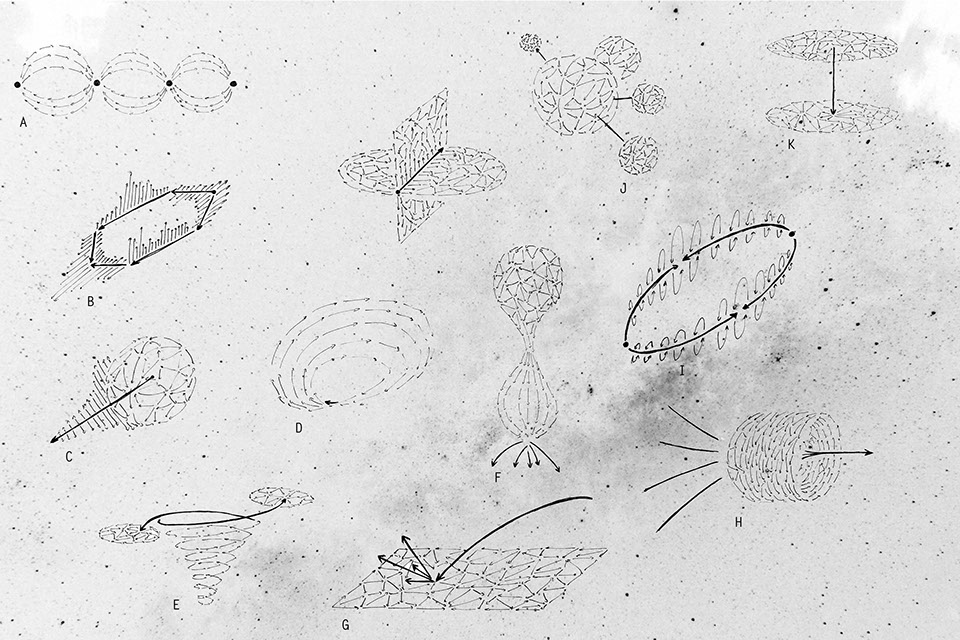
other writings
Graphic Intervention
for art and philosophy magazine Oscillation
Issue 3, theme : anticipation
along with Tristan Garcia, Romain Lucazeau, Romain Bigé, , Jean-Philippe Baselo, and Thomas Hirschorn.
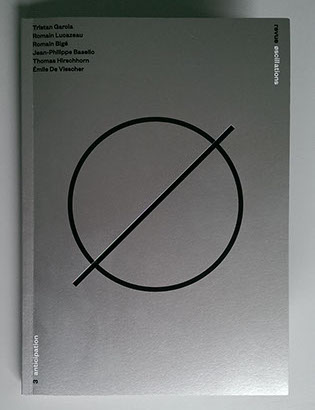
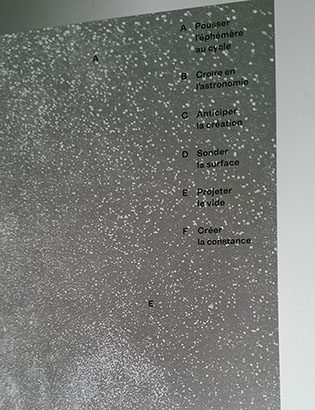
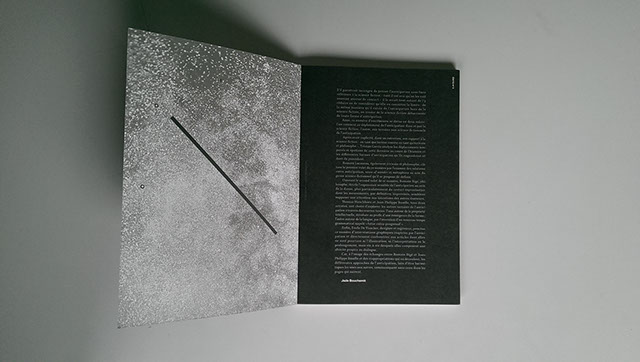
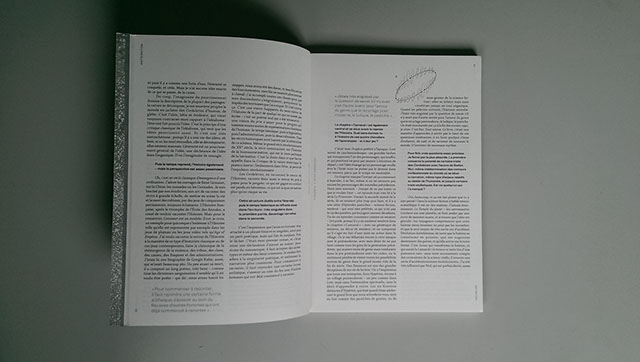
everything can serve
Text for the exhibition catalog
Remix : a new way of Making, curated by Ben Allun Jones, for Frameless Gallery, London
2012
Everything can serve. It goes without saying that we can, not only correct a piece or integrate different fragments of outdated pieces in a new one, but even change the meaning of these fragments and rig, in any form we will judge necessary, what fools persist on calling quotations.
Guy Debord, 1958
The idea of taking someone’s work and transforming it for one’s own purpose is probably one of the oldest practices in our History. However, since the creation of the concept of authorship and the recognition of that as a form of ownership, transforming other people’s works has become a statement, a way to subvert and recreate new content. But remixing is different than a simple quotation. It uses the material of the piece itself: it destroys its integrity, transforms its content, and gives a new order to that previous piece. Instead of working with raw materials, remixing engages with previously informed content - it shapes it differently and gives it a new purpose.
Remix has been widely developed and defined in by the music industry and it has also been the object of much experimentation in the art field. Whether it is the collages of Dada artists, the creation of photo-montages, the works of Warhol, Duchamp, Fluxus, Rauschenberg, all these experiments showed a certain level of remixing of previous content. And the list could fill many pages. But what about design? Why, and how, has the practice of remixing become a major question in design? How does it differ from art and what does it imply for our cultural consumption?
REMIX AT THE CORE OF DESIGN
Design has seen many remixed pieces along its history (the Castiglionis and their Mezzadro Stool, Ron Arad and his Rover Chair, Maarten Baas and his Smoke series, many pieces of Droog Design,...), but the importance of remix in design is much more profound than what these star objects tend to show. In order to understand the importance of remix in design, it is essential to differentiate design from art. Discourses about the boundaries of art and design are endless and often lead to misunderstandings, but; underneath all of these theoretical considerations, there is one little detail that changes everything. It is tiny difference in the law, a drop of words in the oceans of discussions: art never fully belongs to its byer, whereas design does.
“the author of a work of art shall have the right :
(A) to prevent any intentional distortion, mutilation, or other modification of that work which would be prejudicial to his or her honor or reputation, and any intentional distortion, mutilation, or modification of that work is a violation of that right, and
(B) to prevent any destruction of a work of recognized stature, and any intentional or grossly negligent destruction of that work is a violation of that right.” [1]
In the law, even if one is the legal owner an art piece, he cannot change it nor destroy it - he cannot remix it. A design object, on the contrary, is completely in the hands of its buyer and can therefore be transformed, reshaped, misused or even destroyed. Art is not made to be transformed by life events and the changes it produces, whereas design is integrated in life, and cannot remain immaculate. loses its permanency. An art piece will never change in shape, it will go through the years untouched. A design piece will be modified, painted, combined, transformed, repaired, smashed, cut, glued, disassembled, reassembled partially, thrown away, degrade, found back, and maybe eventually put together again.
And this distinction actually changes everything. This difference is at the core of design because objects are appropriated by their owners. Whether it is just by using it, customizing it, transforming it or misusing it, people are defining their environment through creative consumption. Breaking a chair to make firewood, transforming a shelf to make a seat, cutting a barrel to make a barbecue, using books to make a side table, taking a brick to hold books, cutting a mattress to make a sofa, cutting pages of magazines for a wall decoration, transforming a shopping trolley into a rolling seat, a car seat into a sofa, and so on and so forth, are common examples. This very idea of creative consumption has been theorized by Michel De Certeau in his famous book The Practice of Everyday Life:
A une production rationalisée, expansionniste autant que centralisée, bruyante et spectaculaire, correspond une autre production, qualifiée de “consommation”: celle-ci est rusée, elle est dispersée, mais elle s’insinue partout, silencieuse et quasi invisible, puisqu’elle ne se signale pas avec des produits propres mais en manières d’employer les produits imposés par un ordre économique dominant. [...]
To a rationalized, expansionist and centralized, noisy and spectacular production, corresponds another production, described as “consumption”, which is cunning, dispersed, but insinuates everywhere, silent and nearly invisible, because it doesn’t distinguish itself through its own products, but rather through ways of using the products imposed by a dominant economic order.
The tactics De Certeau describes are the remixes of design. Subtle and discrete, this creative consumption of our cultural environment is a way to appropriate objects and attitudes originally built by others. But we might ask: how is that related to actual design and the work of contemporary designers? Well, the answer is very simple: designers have understood these tactics and have started to create for them.
CURRENT TOOLS
I believe the design world has slowly realized the incredible creative potential of those remixes and missuses and have started to integrate these deviations in their designs. It is as if, during the XXth century, design had transformed from proposals of fixed pieces (no adaptation at all), to proposals of designs with potential transformation (modular design, transformable environments, adaptable positions and uses,...). Brought by Italian designers and architects in the sixties, this evolution came as a major break-through against the idea of fixity derived from previous models:
L’idée est que les meubles peuvent se rapprocher ou s’éloigner entre eux. Ainsi, celui qui vit au milieu de ses meubles doit pouvoir s’en approcher ou s’en éloigner, comme de ses amis ou de ses parents, s’il lui vient l’envie de le faire […] J’ai imaginé que, grâce aux technologies avancées ou du moins aux technologies dont on parle tant, on pourrait éliminer, dans la construction des maisons, une série de structures rigides, avant tout celles des équipements, et ainsi chacun pourrait avoir son propre dépôt de liquides, de chaleur, d’air, de détritus et les emporter avec soi où cela lui plaît et quand cela lui plaît.[2]
The idea is that the pieces of furniture can come closer or move away from each other. Thereby, someone living in the middle of those pieces of furniture will be able to come closer or move away from them, like from his friends or parents, if he wants to. […] I have imagined that, thanks to the advanced technologies or at least the technologies we so often talk about, we could get rid, in the building of houses, of a bunch of rigid structures, especially the ones of facilities. This way each of us could have its own store of liquids, heat, air, detritus and could take them along where he wants and when he wants.
This quote from Ettore Sottsass is still extremely relevant. It clearly shows the transformation in the conception of living environments and design. Instead of fixed objects, it develops a thought were elements have plasticity and can be malleable.
This evolution has not stopped in the 60s. More and more, designers have tried to integrate transformation and the creative potential of people in their work. And this reflection of designers has brought us to a paradox nowadays: many designers don’t design objects any more. Because design was concerned with people’s interaction with their environment, it evolved into inventing processes and scenarios to transform the existing environment directly. If we take back the example of Sottsass, it would be as if he had invented a tool that would move and arrange any furniture at home. He wouldn’t have designed any object, just a way to interact with them !
This is, I believe, one of the most interesting movements of this last decade. Interaction design is not only linked to the way we interact with electronic objects. It is much wider and corresponds to that evolution. It develops tools and scenarios on how to interact in a new way with our existing objects. It is a science of remixing, on how to use technologies to tweak existing behaviors and ways to live.More practically, we can clearly see an evolution in industrial design and product design, where surprisingly designers don’t produce product anymore. They design tools of post-production, machines that allows to transform existing materials into new contents, resulting in a plasticity of the material world.
This exhibition is not about remixes, it is about remixing. It’s about a verb, not a noun. The process of remixing the existing represents a new way to think design because it puts into question everything we have around us, looking for ways to transform instead of produce. The exhibition remix is about a process that goes further than a transformation, it takes something common and makes it more relevant. Indeed, remix could be called a transfiguration of the commonplace, like the famous book by art critic and philosoph Arthur Danto. We are now entering an era where all the cultural content around us is a raw material, available for interpretations. We live in a world we have not decided to live in, but remixing allows to transform it and in an extend, to dream about and work towards all the other worlds we could potentially create with the same materials.
_______________________________
[1] Copyright Law of the United States and Related Laws contained in the Article 17 of the United States Code, § 126.
[2] http://fr.wikipedia.org/wiki/Ettore_Sottsass
The difference in repetition
Text for the online magazine
Unmaking Things, curated by RCA's History of Design students.
2012
“One day, perhaps, the century will be Deleuzian” Michel Foucault once declared. Gilles Deleuze is considered as one of the major philosophers of the 20th century. His books are mines of ideas that have influenced many creative fields, to such an extent that they can sometimes appear too prolific and complex. In 1969, Gilles Deleuze published Difference and Repetition, his first book not related to the study of other philosophers. The theses presented then are precursory to the changes happening now in manufacture and design. I will try to explain how and why this incredible work is still relevant in the contemporary design field over 40 years after its release.
THE WILL TO AVOID SAMENESS
Before looking at Deleuze’s ideas and explain its connections to design, we should look back at manufacturing in the 20th century and understand its recent evolutions.
The 20th century has witnessed the development of an incredible invention: mass-production. The aim was to create series of objects, which were interchangeable as they indistinctively shared the exact same qualities and value. Buying a toothbrush for example, is not an act of connoisseurship: there is no difference between the first one and the second one in the rack of a shop. This very idea of sameness is actually incredible: it is neither valid for Nature (we carefully pick fruits and vegetables, being all different), nor for craft (we choose unique pieces that never have exactly the same finish and value, leading to connoisseurship). Only mass-production creates sameness. This idea of different objects sharing exactly the same identity is fundamental to design, because design was created in this context. The process of mechanization of manufactures triggered this need to make the same object over and over – machines are the only tools capable of copying a process exactly. John Ruskin, and later William Morris, saw from early on the problems mechanization was leading to. Unlike what is usually thought, the Art and Craft Movement was not directly against machines themselves, as long as they were considered as tools, but against what they implied: sameness, therefore leading to a segmentation of production and a loss of the craftsman’s skills and sense of pride, eventually creating social degradation. Human beings have never been inclined towards the identical in their work. The fact that we can’t recreate the exact same object over and over is the basis of our evolution – it means there is potential for accidental break-through.
In the last decade, a lot of designers have tried to rethink their relationship to the industry and the machine. The first way was to “disrupt” the repetitive process of the machine. A precursor, Gaetano Pesce created a series of chairs out of polyurethane, where each injection was made with a different pressure, so that the final shape and structural quality would be different for each repetition (nine were made, during a workshop at Pratt College, NYC, 1984). Since then, a great number of designers has been developing new processes where the output is not controlled, even though the process is clearly defined and always identical. One could for instance look at Maarten Baas’s SMOKE series, Oskar Zieta’s PLOPP chairs, or again Jerszy Seymour and his LIVING SYSTEMS, Tokujin Yoshioka and his VENUS installations. So it seems that the 21st century’s zeitgeist is to create difference between each end-object, creating series of different objects from the same process, exactly like each fruit is different even though they grew on the same tree.
This idea is not the preserve of famous furniture designers. Many companies around the world are looking towards new systems of producing difference. The idea is to evolve from producing one million identical objects to one million variations of an object. The majority of new machines are reflecting this tendency: the growing ability to create many different shapes and materials, without any setup time necessary between the changes. CNC machines of course [Computer Numerical Control], but also rapid prototyping machines are purposely made to be volatile; they can create shapes that are each time different without the need to calibrate. Needless to say the integration of electronics and interaction systems also brings opportunities for variation. Interactive objects won’t be all the same, they will evolve in reaction to their environment and will all be different repetitions of a same idea.
THE IDEA OF REPETITION
Deleuze’s Difference and Repetition is the product of a PhD completed in Paris during the turbulent events of May 68. The first strong concept Deleuze tackles is the core idea of repetition. What is a repetition? How can it evolve? Does repetition even exist? According to him, there are two ways of looking at repetition. In the first case – the way of the machines – the repeated information is exactly the same and could be replaced by another, identical information, interchangeable. This repetition corresponds to the exact copy, where the original has the same value as the copy and can be exchanged (like any mass-produced object in a shop). In the second case, the repeated information is never the same as the original. In this case, repetition does not produce identicality, but difference. According to him, the second way of thinking about repetition is the only one relevant for evolution. The first one is “static, the other dynamic. One is ordinary, the other distinctive and singular. One is revolving, the other is evolving.”1. A true repetition is a repetition that evolves. “In every respect, repetition is a transgression.”2. Each iteration corresponds to the same concept but always exceeds its previous repetition. Theatre is a very telling example: even though the actors present the same play every night, it will be different each time and most of the time, the best performance will be the one where major changes occur and lead to improvisations. More relevant to design is the example of the craftsman: even if he repeats the same pattern over time, he masters it, transforms it, adapts it to new trends, new materials. The technique is always the same and the patterns are always similar, but each piece is actually slightly different. “It’s nonsense to copy for a craftsman,” told us Miss Frater, head of a craft school in Kutch, India (Kalha Raksha Institute). Could the same be said about mass-production?
THE IDEA OF THE VIRTUAL / REPRESENTATION
The fact that designers create more and more differentiation among their objects has made new issues arise: how should one represent such works? When designers defined one object they then produced many times, the representation of the project was the object itself, because it encapsulated all the others. But as soon as each iteration becomes different, how does one transmit the idea of the object? Should you show them all? Should you show the making? As design is intrinsically linked to visuality and presentation, an ever-changing object becomes difficult to apprehend. The key point, according to Deleuze, is the capacity to represent iteration. The presentation has to be allusive and represent the whole series, which correspond to Deleuze’s idea of the virtual. According to him, every project has a virtual part, an idea, a concept, a feeling, then translated into different realities. The virtual is not the opposite of the real – it includes it. A real end object is just one iteration of what’s in the head of the designer, many others are possible. All the other objects contained within the virtual idea have to be contained within this one object, in order for the project to be valuable. For example, “each throw of the dice affirms the whole of chance each time. The repetition of throws is not subject to the persistence of the same hypothesis, nor to the identity of a constant rule. [...] Ideas emanate from it just as singularities emanate from that aleatory point which every time condenses the whole of chance into one time.”3. The presentation of an ever-changing project has to capture all the iterations at once. Royal College of Art student Dae Kyung Ahn must have asked himself the question when he did his Micro-Factory for the Innovation Design Engineering department. What is the best way of representing a machine that can potentially cut any 2D shape on a table? How can one unique moment of use contain a complex and inspiring process without being restrictive?
“ONLY THAT WHICH IS ALIKE DIFFERS; AND ONLY DIFFERENCES ARE ALIKE”4.
Design can also be questioned with regards to its users. Deleuze argues that giving a unique solution to a project is socially degrading. In 20th century design, designers created fixity, models, that just waited to be bought and used. According to him, for the relationship to culture and society to be true, participation to the elaboration of the question itself is required. Design objects shouldn’t be just a proposition left to the good will of the consumer, but rather projects open to evolution, for which users are collaborators who can fully participate in their elaboration and reflect on the issues these projects arise. Interactive designs open to evolution and misappropriation are ways to include, not exclude. “As if we would not remain slaves as long as we do not control the problems themselves, so long as we do not possess a right to the problems, to a participation in and management of the problems.”5. Many recent technological projects have given the opportunity to everyone to participate in the design thinking, like Arduino, Linux and the Internet to a broader extent.
These developments are not isolated events; they are striking a chord in every field of design and creation. Royal College of Art’s projects like Sugru are very good example of community based successes. Indeed the very evolution of this project depended on the participation of everyone in the development of possible usages of this versatile material, created to hack deficient object at home. Its inventor Jane Ni Dhulchaointigh, who graduated from Product Design in 2004, explains: “I was inspired by the internet and the whole idea of user-generated content. I wanted something that people could make their own and use in their own way.”6.
I could keep on making parallels between Deleuze’s ideas and current design changes endlessly, but it is time to come to a conclusion. On finishing this incredible book, a strange yet pleasant feeling overwhelmed me: a refined sensitivity to change. Deleuze developed a philosophy of evolution, where nothing is ever identical, and always transforms. He stood against norms and rules, and showed that things never stagnate. Design is always torn between the Industry’s tendency to fix things and its own renewal. For a designer, I believe this book is a message of hope. Deleuze predicted so many of the changes currently occuring, that Foucault might be proven right in the end – perhaps the 21st will be Deleuzian after all.
_______________________________
1. Gilles Deleuze, Difference and Repetition (Continuum Impacts Publishing, 2004), p.27.
2. Gilles Deleuze, p.3.
3. Gilles Deleuze, p.248.
4. Gilles Deleuze, p.142.
5. Gilles Deleuze, p.197.
6. From http://www.telegraph.co.uk/technology/news/6684351/Sugru-Is-this-the-best-invention-since-Sellotape.html [accessed January 2012]
dissymmetric design
Dissertation for the RCA's MA
graded a distinction by Critical and Historical Studies department
2012
INTRODUCTION :
The aim of this dissertation is not to settle a definition of design, nor to define its difference with art. Those question are too vast and contradictory. It will just show and try to elucidate one kind of design and art process that I feel is important, firstly because it is actual (more and more designers are using it and thinking about it), secondly because it is a reaction to the general tendency of having control over life. Everything is designed now, from objects to transport, services and communication. Everything is pre-thought, contained, Pre-maché. “Everyday life becomes more and more artificial and theatralized”1. Just to give a example, a big case that enlightened this phenomenon came from Douglas Bowman, former head of visual design at Google, who left his job because of “data-centrism”. On his blog, we could read: “Yes, it’s true that a team at Google couldn’t decide between two blues, so they’re testing 41 shades between each blue to see which one performs better. I had a recent debate over whether a border should be 3, 4, or 5 pixels wide, and was asked to prove my case.”2 We won’t go further to show that design and other fields of companies like marketing and publicity are all about defining pre-designed experiences. Many people around the world are analyzing and criticizing this phenomenon (Baudrillard, Debord, or more recently Zizek among others). We won’t come back to these critics, not because they are not crucial, but because as designers, we should take them into account and overcome them with new creations.
Thus, the way of designing I will deal with, which I call dissymmetric, is about loosing control, letting things go, use the materials as they are and as they would react normally. But, this “norm” is not the norm that we still have in mind in our everyday. The fact that wood burns should appear as something “normal”, but as most of the wood in the house is fireproof now, or that we have fire controlling systems everywhere, we don’t realize it so much. Plastic melts at relatively low temperatures, but we are surrounded by plastics that can go in the oven also. Were does glass comes from? We only see it in his final shape, transformed, and we don’t realize that each time we go to the beach we are actually bronzing over potential crystal-clear glass (sand). Dissymmetric design is about showing these properties and origins, not hiding them.
Design can be very powerful. It is, after all, one of the creative field that inserts the everyday life so deeply. Asger Jorn points out in his book For Form: “only strangeness can animate reasoning. A completely rationalized and orderly life puts intelligence to sleep, replaced by automatic, routine and sleepwalk reflexes. Intelligence and creative thinking light up by meeting the unknown, the accident, the disorder, the absurd or the impossible. Intelligence is to make possible the impossible, to make the unknown known”3. Novelty and understanding is necessary to everyday life. As designers, we have to take risks. As Hannah Arendt said: “The new always happens against the overwhelming odds of statistical laws and their probability, which for all practical, everyday purposes, amounts to certainty.”4 The idea of this dissertation is to see where design can be new and unexpected, testing what objects are and how they can be revealing themselves.
__________________________________________________________
1.Boris Groys, “Toward a New Romanticism”, in 10th Lyon Biennale - The Spactacle of the Everyday, (publication place: Les presses du Réel, 2009), 64.
2. Douglas Bowman, article “Goodbye Google”, StopDesign blog, posted 20th march, 2009, http://stopdesign.com/archive/2009/03/20/goodbye-google.html (accessed 25 august 2011).
3. Asger Jorn, Pour la Forme (For Form), (Editions Allia, 2001), 47.
4.Hannah Arendt, cited in “Hannah Arendt (1906-1975)”, on Internet Encyclopedia of Phylosophy, http://www.iep.utm.edu/arendt/ (accessed 26 september 2011).
__________________________________________________________
For a complete version, please contact me by e-mail.
